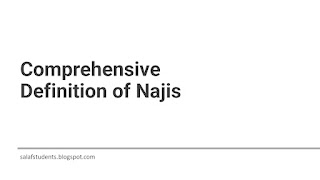Comprehensive Definition of Najis
DEFINITION OF NAJIS
The term "Najis" originates from the Arabic language, derived from the root word "najasah" (Arabic, النجاسة), which etymologically means impurity. In the terminology of fiqh (Islamic jurisprudence), Najis refers to something impure that is commanded by Sharia to be cleansed from clothing, body, and everything that requires purity during use. This includes the cleanliness of clothing and the body during the performance of prayers, tawaf (circumambulation) for Umrah and Hajj, etc.
Ibnu Hajar Al-Haitami in the book "Tuhfatul Muhtaj fi Syarhil Minhaj" (تحفة المحتاج في شرح المنهاج) states that, according to the Sharia definition, Najis is any impure matter that hinders the validity of prayer.
IMPURE MATTERS
Matters or substances considered impure according to Islamic Sharia include:
- Urine, whether from a baby or an adult.
- Feces (human or animal).
- Khamr (intoxicants or alcoholic beverages).
- Carcasses of animals not slaughtered according to Sharia, including flesh, bones, horns, hooves, etc., except for certain exceptions like locusts, marine animals, and very small creatures with non-flowing blood, such as flies.
- Blood.
- Pus.
- Vomit.
- Dogs and pigs.
- Madhi (thin, white fluid emitted without sexual desire).
- Wadi (thick, viscous fluid discharged after urination or carrying a heavy load).
- Sperm (from dogs and pigs).
- Milk from animals whose meat is not halal, except human milk.
IMPORTANT NOTES
- Bones from carcasses are considered pure in the Hanafi school, while hair and fur are considered pure in the Maliki school.
- The excrement and urine of halal animals are considered pure in the Hanbali school.
- It's crucial to distinguish between Najis and Mutanajjis. Najis refers to the impure matter itself, while Mutanajjis refers to an object that has come into contact with impurity. Najis cannot be purified, while Mutanajjis can be purified by removing the impurity.
LEVELS OF IMPURITY
According to the Shafi'i school, impurity is divided into three levels: light (mukhaffafah), medium (mutawassithah), and heavy (mughalladzah).
A. Light Impurity (Najis Mukhaffafah)
- Examples include the urine of a male child under two years old who only consumes breast milk.
- Removal is achieved by pouring water over the impurity, and a single pour is sufficient.
B. Medium Impurity (Najis Mutawassithah)
- Examples include blood, carcasses, human or animal feces, vomit, urine, etc.
- Purification involves removing the impure substance, then pouring water over the area. If the impurity is gone, a single pour is sufficient.
C. Heavy Impurity (Najis Mughalladzah)
- Examples include impurities from dogs and pigs.
- Purification requires removing the impurity and washing the affected area seven times, with one of the washes mixed with dust or soil.
TYPES OF IMPURITY
There are two types of impurity: Hukmiyah (legal impurity) and Ainiyah (perceptible impurity).
1. Legal Impurity (Najis Hukmiyah)
- Impurity that is not visibly apparent in terms of color, smell, or taste.
- Purified by a single pour of water.
- The water used for purification is considered complete (mutakmal) but cannot be used to purify other impure items or for ablution (wudu).
2. Perceptible Impurity (Najis Ainiyah)
- Impurity that is visibly apparent in terms of color, smell, or taste.
- For example, if you see urine on the floor, that urine is considered perceptible impurity.
- Purification involves removing the impure substance and then pouring water over the area.
REMOVING IMPURITY
The method of removing impurity depends on its level (light, medium, heavy) and type (Ainiyah or Hukmiyah).
1. Removing/Liquidating Light Impurity
- Pour clean water over the impurity once.
2. Removing/Liquidating Medium Impurity
- Remove the impure substance and then pour clean water over the area.
- If the water used for purification is less than 2 qullah, it must flow over the impure object. If it is 2 qullah or more, pouring directly onto the impure object is sufficient, unless one of the three characteristics (color, smell, or taste) changes, in which case the water remains impure.
3. Removing Heavy Impurity
- For impurities from dogs and pigs, wash the impurity seven times, with one wash involving mixing with dust or soil.
Using Dust to Remove Impurity
- Pour water first and then place dust on the impurity to clean it.
- Place dust or soil on the impure area and then wash it with water.
- Mix dust with water and use it to wash the impure area.
Related : Hadith On Sea Water





